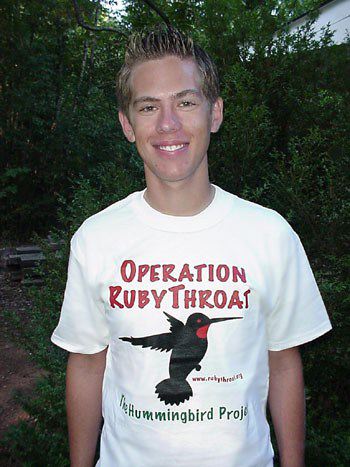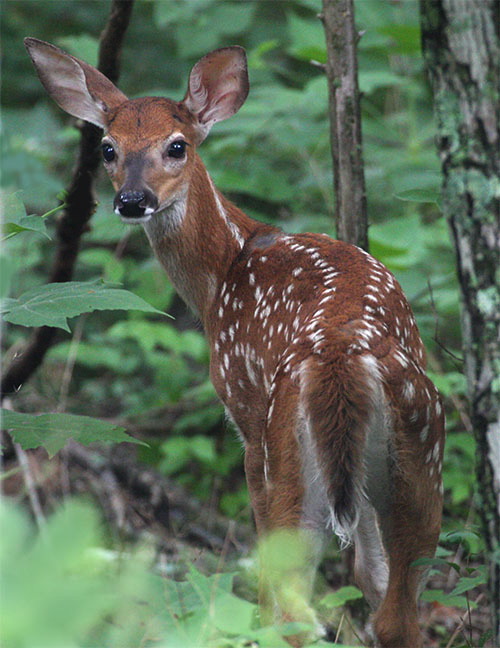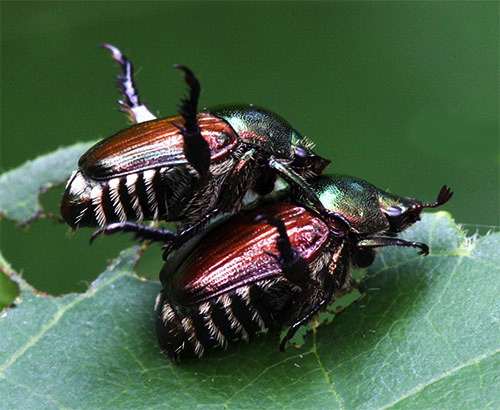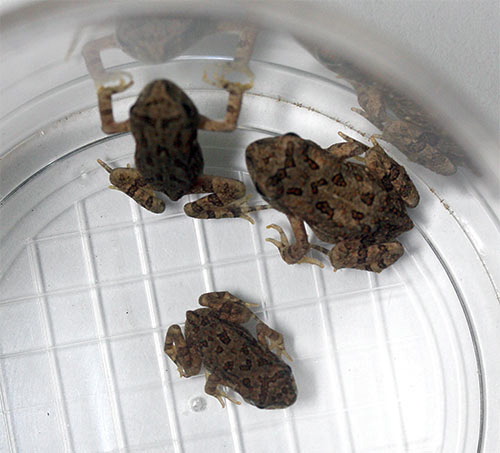|
|
|||
|
(Back to Preceding Week; on to Next Week) |
|
EVIDENCE FOR
During those too-frequent times when we're stuck at our desk rather than being out and about at Hilton Pond Center, we try to keep a camera at hand--just in case some photographable natural occurrence comes to pass. We use a variety of interchangeable lenses including a wide-angle one for landscape shots, a couple of different macros for close-ups, and a "normal" lens for "normal" photos (whatever those may be), but we mostly keep the camera outfitted with our 100-400mm zoom telephoto lens. This optical set-up offers the greatest chance of capturing images of ducks diving on the pond or wildlife wandering past the office window. This week we made use of almost all our lenses and captured images that are sure evidence of breeding success among animals that live around Hilton Pond. We have no long stories to tell about any of them but hope you'll enjoy what photos we have to share.
All text & photos © Hilton Pond Center The photo above illustrates just why we keep a telephoto lens mounted on our camera. As we were checking e-mail messages one morning this week, we glanced out the window and noticed a full-grown White-tailed Deer cautiously making her way across a small clearing that lies between the Center's old farmhouse and Hilton Pond itself. Assured there was nothing to fear, the doe turned and pawed the ground once, apparently signaling for her weeks-old fawn to follow--which it did. As we carefully unlatched and opened the patio door beside our desk to provide an unimpeded view, the doe snapped to attention and her fawn simultaneously turned its head in the direction of the sound. We had only a few seconds to raise and focus the camera and make several exposures of the dappled young deer--ears alert and already learning how to survive in a world fraught with potential dangers.
Considerably less wary than our small herd of White-tailed Deer is a horde of Japanese Beetles that does its best to defoliate local flora. After working over the leaves of invasive and undesirable Multiflora Rose bushes, these herbivorous beetles settle in on native Wild Grapes that are becoming increasingly plentiful around Hilton Pond. It's a wonder our grapevines are able to produce any fruit at all because virtually none of their photosynthesizing leaves go un-gnawed by voracious Japanese Beetles. Perhaps the ONLY thing that deters these non-native insects from eating everything in sight is the opportunity to mate; in the macro shot above the male beetle--hind legs aloft--appears to be in for a wild ride as he attempts to mount a female.
Of the 30-plus Wood Warbler species that pass through the Carolina Piedmont in spring migration only a few linger to breed, but those that do brighten the summer months like few other birds can. Among the most distinctive is the Kentucky Warbler, one of which--a juvenile already bringing in the bright colors of an adult--was caught this week in a mist net at Hilton Pond Center. The brilliant yellow of the bird's undersides, superciliary line, and eye ring--coupled with a dark mask and cap--make it easy to identify this Neotropical migrant that will spend the winter somewhere between Mexico and northern South America. We suspect this species breeds at the Center but it's certainly not plentiful; the bird above was only the 19th Kentucky Warbler we've banded locally in 26 years, the first since 2003.
Quite a bit less colorful--and much less distinctive--than the Kentucky Warbler was the small brown bird above; we've included several fingers in the photo to provide a sense of scale. Novice birders--and some experienced ones--might have difficulty identifying this individual, which we also caught this week at Hilton Pond Center. The most useful field marks are the bird's size, its wing color (including buffy wingbars), and shape of the bill. The most misleading characteristics are the striated head and fine streaking on the breast and otherwise grayish rump. Even some field guides do not show this plumage. Rather than give away the identification, we encourage you to ponder it a while and make an educated guess. (We'll reveal the name of this "mystery bird" somewhere below, so please keep reading.)
Some of our most pleasant hours in life have been spent in the saddle of a finely tuned road bicycle, most recently a top-of-the-line carbon-fiber Fuji that is pure delight to ride. On summer mornings--before the heat rises--we often pedal the back roads of York County for an hour or so, taking in the day-to-day changes of the rural countryside. When we return to Hilton Pond, we park the bike on the porch and go inside the old farmhouse to cool off, sometimes forgetting to retrieve the machine until later that day. Such was the case one evening this week when we remembered we had left the bike outside and went to retrieve it at dusk. As we reached for the handlebars we did a double-take; there seemed to be far too much dark mass in the vicinity of the seat and saddlebag. Upon quick inspection we discovered a young, three-foot-long Black Ratsnake had climbed aboard and wrapped its sinewy body around the bag and seatpost. Rather than mess with this harmless snake--we did NOT want it to get excited and spray musk all over the bike--we went back indoors for an hour or so. When we returned the serpent had slithered away, probably content there were no baby birds or mammals nesting atop the Fuji. (We hope the snake--which probably hatched last year and not in 2008--didn't think a folding spare tire under the seat bag was a relative run over and flattened by some inattentive driver.) Moral of the story: ALWAYS check you bicycle before bringing it back indoors.
When schoolchildren and other groups visit Hilton Pond Center for Guided Field Trips, we ask them to follow a few guidelines to minimize impact on our flora and fauna. Our first request is "Don't step on anything green," an attempt to get folks to stay on the trails and to be careful where they walk--lest some small but significant plant get smashed. For the past few weeks, however, we've also said "And don't step on anything brown, either!" This new mndate came about because this summer, for the first time in 26 years, there are dozens of miniature brown toads hopping around the Center. If we walk slowly down the path the tiny creatures see us coming and jump out of the way, but if we move too quickly the little amphibians remain underfoot and become two-dimensional. To illustrate just how small these baby Fowler's Toads really are, we gathered up a trio and placed them in a collecting jar whose bottom is inscribed by a 5mm grid (above). In the English system these are roughly three-sixteenth-inch squares, meaning the smallest individual in the photo above measures barely a half-inch from snout to rump. (The photo below shows the smallest toad's actual size.) Assuming these tiny toadlets aren't squished or eaten by some predator, they will dine on insects and other invertebrates and grow rapidly through the summer, perhaps reaching an inch and a half before hibernating. As mature adults, Fowler's Toads--common across South Carolina above the fall line--can reach a length of 3.25". We almost never see toads this big around Hilton Pond, and we're at a loss as to why this year--all of a sudden--we have such a huge influx of toadlets.
So that's our photo portfolio for the first half of July 2008: A white-tailed Deer fawn, hormonally charged Japanese Beetles, a couple of juvenile songbirds, a bike-riding snake, and the tiniest toads we've ever seen--all signs of breeding success for at least six animal species at Hilton Pond Center.
All text & photos © Hilton Pond Center
Comments or questions about this week's installment?
Thanks to the following fine folks for recent gifts in support of Hilton Pond Center for Piedmont Natural History and/or Operation RubyThroat: The Hummingbird Project. Your tax-deductible contributions allow us to continue writing, photographing, and sharing "This Week at Hilton Pond." (Please see Support if you'd like to make a gift of your own.)
"This Week at Hilton Pond" is written & photographed You may wish to consult our Index of all nature topics covered since February 2000. You can also use our on-line Hilton Pond Search Engine at the bottom of this page. For a free, non-fattening, on-line subscription to |
|
Make direct donations on-line via
Network for Good: |
|
|
Use your PayPal account
to make direct donations: |
|
|
If you like to shop on-line, you please become a member of iGive, through which more than 700 on-line stores from Barnes & Noble to Lands' End will donate a percentage of your purchase price in support of Hilton Pond Center and Operation RubyThroat. For every new member who signs up and makes an on-line purchase iGive will donate an ADDITIONAL $5 to the Center. Please sign up by going to the iGive Web site; more than 150 members have signed up to help. It's a painless, important way for YOU to support our work in conservation, education, and research. |
|
| The highly coveted Operation RubyThroat T-shirt (four-color silk-screened) is made of top-quality 100% white cotton. It highlights the Operation RubyThroat logo on the front and the project's Web address (www.rubythroat.org) across the back.
Now you can wear this unique shirt AND help support Operation RubyThroat: The Hummingbird Project and Hilton Pond Center. Be sure to let us know your mailing address and adult shirt size: Small (suitable for children), Medium, Large, X-Large, or XX-Large. These quality shirts don't shrink! Price ($21.50) includes U.S. shipping. A major gift of $1,000 gets you two Special Edition T-shirts with "Major Donor" on the sleeve. |

Need a Special Gift for a Want to make a If so, why not use our new handy-dandy on-line Google Checkout below to place your secure credit card order or become a Major Donor today? |
|
|
|
|
SPECIES BANDED THIS WEEK: * = New species for 2008 WEEKLY BANDING TOTAL 12 species 52 individuals YEARLY BANDING TOTAL (2008) 46 species 1,068 individuals 29 Ruby-throated Hummingbirds 27-YEAR BANDING GRAND TOTAL (since 28 June 1982) 124 species 51,235 individuals NOTABLE RECAPTURES THIS WEEK (with original banding date, sex, and current age) 2008 Ruby-throated Hummingbird returns from past years--23 Ruby-throated Hummingbird (15) American Goldfinch (3) Northern Cardinal (1)
|
OTHER NATURE NOTES OF INTEREST --Our first Hummingbird Morning of the summer is coming up on 1-3 August at the annual HummerFest for the Nature Station, Land Between the Lakes KY. We'll be lecturing and banding hummingbirds for the public at this popular annual event. If you've ever wanted to see up to 200 hummingbirds at once, this is the place. Details at Hummingbird Mornings 2008. See you there! --Ruby-throated Hummingbirds FINALLY began to appear in decent numbers this with at Hilton Pond Center. With just two banded in April, none in May, and seven in June, we were pleased to band 22 in the first half of July. Equally exciting were the 15 returns we caught during the period (see below left), bringing the season total to 23. (Our average number of returns since 1984 also happens to be 23, with last year's 49 returns being 13 more than the previous record.) Only two of the returns were males, and one was an after-fourth-year female in at least her fifth year of life. Of 29 RTHU banded to date, 16 have been adults; we expect a significant increase in the number of young hummers as the season progresses.
--The smallish "mystery bird" in the photo essay above is one of a few sparrows that breed in the Carolina Piedmont and around Hilton Pond. Our give-away hint is "otherwise grayish rump," which means the bird has to be a juvenile Chipping Sparrow. As fall approaches, it will lose the streaking on its breast and rump and eventually will develop a rusty cap and black upper mandible when it enters its first breeding season next spring. Three chips if you got the ID on your own! All text & photos © Hilton Pond Center
|
|
|
|
(Back to Preceding Week; on to Next Week) Up to Top of Page Back to This Week at Hilton Pond Center Current Weather Conditions at Hilton Pond Center |
 You can also post questions for The Piedmont Naturalist |
Join the |
Search Engine for |
|
|
Online promotion codes









 Please report your
Please report your